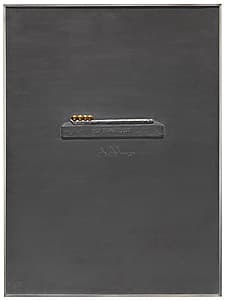

Jasper Johns
Learn moreThe critic smiles; from Lead relief series 1969
© Jasper Johns. VAGA/Copyright Agency Purchased 1973
More detail | PermalinkAt a time when the emotionally-charged paintings of Abstract Expressionism dominated the American avant-garde, Jasper Johns began to reframe everyday objects and symbols as valid subjects for fine art. Drawing influence from the traditions of Dada—particularly the absurdist humour and use of ready-made subject matter—his work was identified with the Neo-Dada movement and became a foundation for American Pop art.
Johns was interested in the idea of reproducibility and he constantly appropriated his own work, returning to motifs time and again across different media. The Lead relief series 1969–70 reconstructs some of his most iconic and recurrent motifs—the American flag, a lightbulb and numerals—in editions of embossed lead sheets. The other three reliefs in the set also revisit earlier ideas and works. Composed of a toothbrush with teeth in place of bristles, The critic smiles returns to the subject of the artist’s 1959 sculpture of the same title,[i] which was intended as a sardonic response to art critics who had given him bad reviews:
I had the idea that in society the approval of the critic was a kind of cleansing police action. When the critic smiles it’s a lopsided smile with hidden meanings. And of course a smile involves baring the teeth. The critic is keeping a certain order, which is why it is like a police function.[ii]
Alice Desmond
[i] Collection of the artist.
[ii] Jasper Johns, quoted in Jane Kinsman The art of collaboration: The big Americans, National Gallery of Australia, 2002, p 20.

